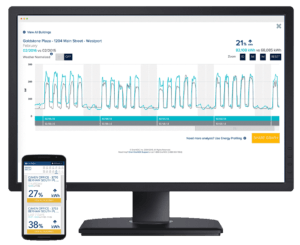EnerNOC: Taking Power Away from the Energy Utility Monopoly

Growing environmental awareness, rising energy prices and lack of transparency in the power supply system have contributed to the adoption of EnerNoc’s energy intelligence software.
The utility business model has remained largely unchanged over the last decades. It relies on economies of scale to supply energy at low cost to users in geographic areas over which they have state-granted monopolies. Most consumers can’t choose the source of the energy they use (i.e. renewable energy versus fossil fuels). Additionally, the lack of energy consumption data and the complicated pricing structure makes it difficult for end users to predict energy costs.
EnerNOC appeared on the map in 2010 as a demand response program provider. Demand response refers to the way energy consumers adapt their energy consumption to energy prices during a day or season. The demand response segment is highly fragmented and competition is fierce so, in 2013, EnerNOC launched its Energy Intelligence Software Platform (EIS) to provide businesses with key real-time data to manage their energy consumption. This approach has allowed the company to differentiate itself from other players in the space and has since become the largest energy intelligence provider in the US. It provides several tools and services through the platform focused on four main areas:
- Real-Time Monitoring and Facility Optimization Analysis: helps businesses identify under-performing assets and cut unnecessary energy costs.
- Project Tracking: helps project management keep track of efficiency initiatives.
- Utility Bill Management: streamlines utility bill management and helps avoid payment errors.
- Sustainability Reporting: automates sustainability reporting to regulators.
The market size for the energy management software is estimated to be $5 billion. However, the value created for the end user is multiple times larger as small efficiency improvements can result in millions in savings for a single industrial or commercial facility every year. Current EnerNOC clients include Pepsico, 3M, Philips, General Motors.
EnerNOC uses an enterprise SaaS model and is aiming to establish a solid base of subscription revenue via the EIS platform. The SaaS model will allow the company to scale rapidly as it can service many users with a single platform to which developers can consistently add new functionality.
Regarding the go-to-market strategy, the company is well positioned to leverage its growing brand name and large user base to increase the rate of adoption of the EIS platform. Even though sales cycles for the enterprise sector are usually long. EnerNOC is working to streamline the sales process by allowing potential customers to estimate energy savings via online simulations. Lead generation efficiency should increase considerably given that by the time a potential client reaches a sales agent she is completely aware of the benefits of using the EIS platform.
EnerNOC was bought by Enel for $300 million in June 2017 and they intend to use it as a “foundational element” in its E-Solutions business unit. Francesco Venturini, head of the division, mentioned they are going to pursue a range of markets with this platform: “electric mobility, vehicle-to-grid projects, recharging infrastructure, energy-efficiency management, batteries and energy optimization platforms, public lighting and distributed generation systems.”
As EnerNOC grows its user base, it should think about opening the platform to the developer community at large. This way it can take advantage of the network effects by attracting more developers which in turn will increase EnerNOC’s value proposition and attract more businesses to the platform.
Even though EnerNOC’s future may still be uncertain, the traditional way businesses manage their energy consumption is certainly going to change. Perhaps even faster that we might imagine.
Sources:
https://www.enernoc.com/products/
https://www.greentechmedia.com/articles/read/enel-to-buy-enernoc-for-250-million#gs.synWXkU




Great post! Wonder if they’ve made any inroads into emerging markets. Speaking for Brazil’s case – the volatility of energy prices due to swings in water reservoir levels (hydro power is the main power source) – is a major headache for businesses and one that is set to worsen with climate change. I can also see the government backing their entry, which always makes things easier for breaking into a LatAm market.